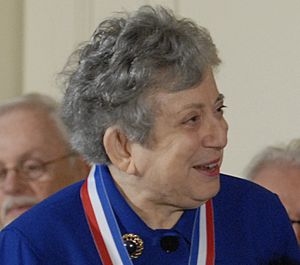Fay Ajzenberg-Selove facts for kids
Quick facts for kids
Fay Ajzenberg-Selove
|
|
|---|---|

Fay Ajzenberg-Selove receiving the National Medal of Science in 2008
|
|
| Born | February 13, 1926 |
| Died | August 8, 2012 (aged 86) |
| Alma mater | |
| Known for | Nuclear spectroscopy |
| Spouse(s) | Walter Selove m. 1955 |
| Scientific career | |
| Fields | Nuclear physics |
| Institutions |
|
| Doctoral advisor | Hugh Richards |
| Notable students | Gloria Lubkin (MA, Boston University, 1957) |
Fay Ajzenberg-Selove (born February 13, 1926 – died August 8, 2012) was an important American scientist. She was a nuclear physicist. She studied the tiny parts inside atoms, especially how light elements behave. She also wrote yearly reports about the energy levels of these tiny atomic parts. In 2007, she received the National Medal of Science, a very high honor for scientists in the United States.
Contents
Early Life and Education
Fay Ajzenberg was born on February 13, 1926, in Berlin, Germany. Her family was of Polish Jewish background. Her father, Moisei Ajzenberg, was a mining engineer. Her mother, Olga Ajzenberg, was a talented pianist and singer.
In 1919, her parents left Russia because of the Russian Revolution. They settled in Germany, where her father became a successful banker. However, the family lost their money during the Great Depression.
Because of this, they moved to France in 1930. Her father worked in a sugar factory. Fay went to school in Paris. In 1940, her family had to flee Paris because of the Nazi invasion. They traveled through many countries, including Spain and Cuba. Finally, they arrived in New York City in April 1941.
Fay finished high school in 1943. Her father always encouraged her interest in engineering. She went to the University of Michigan. She was the only woman in her engineering class of 100 students. She earned her bachelor's degree in 1946.
After some more studies, she began her PhD at the University of Wisconsin–Madison. There, she worked with nuclear physicist Hugh Richards. She studied the energy levels of light atoms. She found new ways to create special materials for her experiments. She also showed that the energy levels of the boron nucleus were not as simple as thought. She received her master's degree in 1949 and her PhD in physics in 1952.
Physics Research and Career
After getting her PhD, Fay Ajzenberg worked at the California Institute of Technology. She worked with Thomas Lauritsen. Together, they started publishing important yearly reports. These reports were called Energy Levels of Light Nuclei. They collected the best research on how light atomic nuclei are built and how they decay.
These reports became very important for nuclear scientists. People even called them "the nuclear scientists' bible." After 1973, Fay Ajzenberg published these reports by herself. She published 26 of them, mostly in the journal Nuclear Physics, until 1990.
Later, Ajzenberg became an assistant professor at Boston University. When the dean found out she was a woman, he tried to lower her salary. Fay refused the job until her original salary was given back. This showed her strong will and determination.
In 1955, she married Walter Selove, a physicist from Harvard University. Her student, Gloria Lubkin, later became the first female editor-in-chief of Physics Today magazine. In 1962, her husband Walter discovered a new particle. He named it the fayon (f2) in her honor.
In the 1960s, Fay Ajzenberg-Selove worked at Haverford College. She was the first full-time female professor there. In 1970, she started teaching at the University of Pennsylvania. Her husband also taught there.
In 1972, she applied for a permanent teaching position, called tenure. She was not given the job. The university said she was too old and didn't have enough research published. However, Fay was only 46. She had published many important papers. Her research was cited by other scientists more than almost anyone else in the physics department. She was also the head of the Nuclear Physics Section of the American Physical Society.
Fay Ajzenberg-Selove believed she was being treated unfairly because she was a woman. She filed complaints with government groups that protect against discrimination. In 1973, the University of Pennsylvania was ordered to give her the permanent professorship. She became only the second female professor in the university's School of Arts and Sciences.
Honors and Awards
Fay Ajzenberg-Selove received many awards for her important work.
- Fellow, American Association for the Advancement of Science
- Fellow, American Physical Society
- Chair, American Physical Society Division of Nuclear Physics (1973-1974)
- Award for Distinguished Teaching, Christian and Mary Lindbeck Foundation (1991)
- Nicholson Medal for Humanitarian Service, American Physical Society (1999)
- Distinguished Alumni Fellow Award, University of Wisconsin Department of Physics (2001)
- National Medal of Science (2007)
Images for kids
See also
 In Spanish: Fay Ajzenberg-Selove para niños
In Spanish: Fay Ajzenberg-Selove para niños


